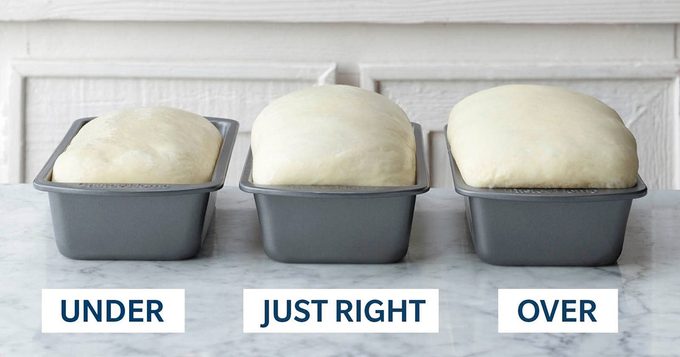
Dry ingredients will absorb wet ingredients more slowly in cold temperatures the molecules have less energy and so move more. I like to let my dough rise at 68F if its a lean dough at slightly higher temperatures if it is enriched 74F seems to be ideal.

The temperature where yeast grows best is around 78 degrees.
Best temperature for bread dough to rise. Proofing at a cool room temperature below 72 degrees Fahrenheit took 2½ hours for the bread to double in size and yielded loaves with a decent brown crust and an even rise. Proofing in the oven took half as long but resulted in loaves with alcoholic aromas less-browned crusts and a. I like to let my dough rise at 68F if its a lean dough at slightly higher temperatures if it is enriched 74F seems to be ideal.
Unless you have a proofing box its difficult to. Temperature can affect the rising of bread dough both directly and indirectly. Indirectly the temperature and atmospheric pressure surrounding the dough will affect how all the ingredients behave especially the flour.
Dry ingredients will absorb wet ingredients more slowly in cold temperatures the molecules have less energy and so move more. Conversely dough that rises too quickly produces bread with flat flavor. Nail the sweet spot warm enough to rise at a decent rate yet cool enough to develop flavor and youre golden.
Studies have shown that the optimum temperature for yeast to grow and flavor to develop is 75F to 78F. Optimal yeast growth happens at around 37 degrees Celsius 986 degrees Fahrenheit but dough will rise at any room temperature. As the temp rises the yeast becomes more active which is why youll sometimes see recipes call over overnight rests in the fridge where activity slows or stops.
Yeast dies at anything above 50 C 122 F. If you want to know what changes in the dough when the bread proofing temperature and humidity alters and how long bread takes to rise read on. The ideal temperature to proof bread depends on the bread you are making.
High output bakers will set their proofers at 38C 100F yet artisan bakers prefer slower rises. The oil will prevent the dough sticking to any part of the bowl or film. Next place your bowl in the middle of your completely cold and not switched on oven.
On the very bottom of the oven place a small bowl and fill it with water that has just been boiled. Close the oven door and leave the dough. Whereas proofing bread dough also known as the final fermentation is when you let the dough rise between 75 and 80ºF.
This process can be done in either a glass bowl at room temperature the oven a slow cooker or a proofing box. 4 Ways to Proof Bread Dough Here are four tried-and-true ways to proof bread in cold and warm kitchens alike. Most doughs rise faster in a warm and humid environment.
Here are some ideas on warm places to let your dough rise. Oven a Turn on the oven for about one minute and turn it off. Place dough in the warm oven.
B Place a pot of boiling hot water in a cold oven. The temperature where yeast grows best is around 78 degrees. The temperature of the dough is the result of the temperature of the water that you use the flour temperature and the temperature in your kitchen.
Water that is 110 to 115 degrees mixed with cooler flour is intended to create a dough temperature close to this 78 degrees. Best baking temperature for bread The standard bread baking temperature is somewhere between 220C 430F and 230C 450F. Whole wheat breads and loaves with seeds or other toppings become less appealing with too much colourisation.
These should be baked at 220C 430F. Temperature Guidelines A universal temperature that works well for a wide variety of breads is 81 F 27 C. If you love simplicity just.
Sourdough works in a range of 70-85 F 21-30 C. Warmer temps of 85 F 30 C will help promote acidity in. Commercial yeast is vigorous and.
How long should your bread rise. That depends on the temperature of your kitchen. Yeast the agent that allows bread to rise is very sensitive to temperature.
The best way to tell if your dough has risen enough is not by timethough it helps to set the timer so you dont forget about your doughbut by. Yes you can let your bread rise overnight in the fridge. Keep in mind though youll want the dough to come back up to room temperature before baking.
If you want your dough to develop a slightly sour flavor you can leave the dough at room temperature to rise but youll need to punch it down reshape and allow it to rise again before baking. For lean-dough breads the recommended doneness is 190210F 8899C while rich-dough breads are done at 180190F 8288C. These critical temps are important if you want bread that is cooked through and not gummy in the center but is still moist and tasty.